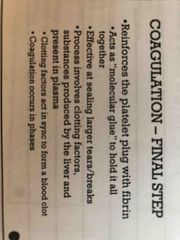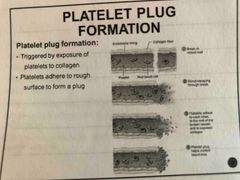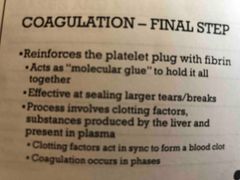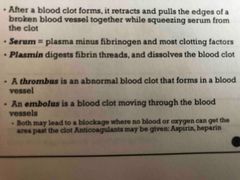![]()
![]()
![]()
Use LEFT and RIGHT arrow keys to navigate between flashcards;
Use UP and DOWN arrow keys to flip the card;
H to show hint;
A reads text to speech;
56 Cards in this Set
- Front
- Back
- 3rd side (hint)
|
Blood is the only? |
Fluid tissue in the body |
|
|
|
What type of tissue is blood? |
Connective tissue |
|
|
|
Average adult has around how many liters of blood? |
5 L |
|
|
|
Is blood thicker than water? |
Yes about five times thicker than water (viscosity) |
|
|
|
What vital substances does blood transport ? |
Blood distributes heat and transports nutrients, gases, etc. |
|
|
|
What three parts is a whole blood made up of? |
Plasma, RBCs, WBCs |
|
|
|
Plasma consist of? |
Water, proteins, urea, Uric acid, electrolytes, O2, CO2, nutrients like glucose and cholesterol, hormones |
|
|
|
% RBCs in sample of whole blood is the? |
Hematocrit |
|
|
|
What is he Hematopoiesis? |
The production of formed elements RBCs, wbc’s, and platelets Where? Red bone marrow especially in flat bones like sternum cranial cap, ilium, head of the femur and humerus. How? Or blood cells come from Hematopoietic stem cells |
|
|
|
Stem cells can? |
. Give rise to more stem cells. .Give rise to more specialized or differentiated cells in response to Hematopoietic growth factors. . Lymphoid stem cells . Myeloid stem cells |
|
|
|
Lymphoid stem cells give rise to? |
Lymphocytes |
|
|
|
MyEloid stem cells give rise to? |
all other types of formed elements red blood cells, other types of white blood cells and platelets |
|
|
|
Erythrocytes are? |
RBC’s |
|
|
|
No nucleus or organelles in mature? |
RBC’s |
|
|
|
Can RBCs divide? |
No |
|
|
|
RBCs are filled with? |
Hemoglobin to carry O2 and CO2 |
|
|
|
Erythropoieses occurs where? |
In red bone marrow |
|
|
|
What is ERYHTROPOIESIS? |
Rbc formation |
|
|
|
Average lifetime for RBCs? |
120 days |
|
|
|
Average lifetime for RBCs? |
120 days |
|
|
|
Low blood 02 calls his kidneys and liver to release the EPO (erythropoietin) which stimulates RBC production what other things can Stimulate EPO release? |
Heavy bleeding, Hi altitude, iron deficiency, intense exercise. |
|
|
|
What is anemia? |
Condition in which the O2 carrying capacity of the blood is reduced, due to deficiency of RBCs or hemoglobin. |
|
|
|
What is blood doping? |
. Drawing out RBCs then reinjecting before major athletic event. . Increases hematocrit to about 60% .Increases O2 caring capacity. over a 25% increase in O2 carried/100 ML’s . Enhances endurance and speed |
|
|
|
Excessive RBC distraction means? |
Bilirubin accumulates in blood =Jaundice |
|
|
|
What is leukocytes function? |
Kills, immobilizes, or removes pathogen‘s. |
|
|
|
What is leukocytes function? |
Kills, immobilizes, or removes pathogen‘s. |
|
|
|
Our leukocytes considered True cells? |
Yes. (only true cell) |
|
|
|
What is leukocytes function? |
Kills, immobilizes, or removes pathogen‘s. |
|
|
|
Our leukocytes considered True cells? |
Yes. (only true cell) |
|
|
|
Where do leukocytesPerform their work? |
Outside of blood vessels. ...Diapedesis -WBC’s slip out a blood vessel’s. ...Positive Chemotaxis follow chemical trail left by other wbc’s or damaged cells. |
|
|
|
Classification of the five leukocytes |
Granulocytes:Have granules filled with hydrolytic enzymes or anti-microbial proteins in cytoplasm . Neutrophil . Eosinophils . Basophils Agranulocytes: no granules in cytoplasm. . Monocytes . Lymphocytes(T & B) |
Never let monkeys eat bananas |
|
|
Neutrophils |
Small, light purple granules First to arrive at infection site Strong phagocytes Elevated in bacterial infections |
|
|
|
Eosinophils |
Course granules deep red and acid stain Moderate allergic reaction Defend against parasitic worm infestation Elevated in parasitic worm infestation and allergic reactions |
|
|
|
Basophils |
Large granules stain deep blue in basic stain Granular’s can obscure the view of nucleus Release histamine to stimulate inflammation Release heparin to stop blood from clotting Similar to Eosinophils in size and shape of nuclei |
|
|
|
Monocytes |
Largest of the WBCs
Agranulocyte Leave bloodstream to become macrophages Live for weeks to months |
|
|
|
Lymphocytes |
Slightly larger than RBCs smallest wbc Surrounded by thin rim of cytoplasm A granulocytes T cells and B cells are major types of both important in immunity T cells directly attack pathogen‘s, tumor cells B cells produce anti-bodies May live for years |
|
|
|
Functions of WBCs |
Phagocytosis – engulfing and digestion of pathogen’s neutrophils and monocytes are most mobile and active phagocytes. Inflammatory response – reaction that restricts spread of infection promoted by basophils by secretion of heparin and histamine, involves swelling and increased capillary permeability |
|
|
|
Platelets (thrombocytes) |
Help in hemostasis in damage blood cells by sticking to broken services.(stoppage of bleeding) Release serotonin, which causes smooth muscle in walls of broken blood vessel‘s to contract(this reduces blood flow) |
|
|
|
Plasma |
Blood plasma Clear, straw-colored Liquid portion of blood 55% of blood volume 92% water contains organic and inorganic chemicals Transports nutrients, gases, hormones and vitamins Helps regulate fluid and electrolyte balance and maintain pH |
|
|
|
Most important blood gases are? |
Oxygen and carbon dioxide |
|
|
|
Plasma nutrients are? |
Amino acids Simple sugars Nucleotides Lipids– Fats(triglycerides), phospholipids, cholesterol |
|
|
|
Electrolytes found in blood plasma? |
Sodium Potassium Calcium Magnesium Chloride Bicarb Phosphate Sulfate .Sodium and chloride or most abundant electrolytes |
|
|
|
Plasma electrolytes contain a |
.Variety of ions calledElectrolytes, since they ionize in water, and can conduct electricity that have a charge. .They are absorbed from the intestines or released as byproducts of Cellular metabolism |
|
|
|
What is hemostasis? |
The stopping of bleeding at the blood vessel. |
|
|
|
What are the three major processes that occur in hemostasis in the correct order? |

1. Vascular spasm Dash smooth muscle contraction causing vasoconstriction slows blood loss/allows time for steps two and three 2. Platelet plug formation 3.Blood coagulation *Hemostasis is controlled by positive feedback |
|
|

Front (Term) |

Back (Definition) |
|
|
|
Fate of blood clots? |

Back (Definition) |
|
|
|
Thrombosis |
Blood clot in a vessel supplying a vital organ (heart or brain) |
|
|
|
Infarction |
Death of tissues that have blocked blood vessels due to blood clot formation |
|
|
|
Embolism |
Blood clot that travels, and then blocks a blood vessel in in Organ (such as pulmonary embolism in lungs) |
|
|
|
Atherosclerosis |
Accumulation of fat in arterial linings can sometimes cause abnormal clot formation, a common form of thrombosis |
|
|
|
For blood types Type A,B,O, or AB |
RBCs have antigens (ID tags)on their cell Either A or B antigens or both This determines your blood type |
|
|
|
Antigen ID tags |
Any molecule that evokes and immune response. If immune system finds a foreign antigens in the body, it produces anti-bodies against the antigen |
|
|
|
Anti-bodies |
Proteins that react against a specific antigen. In an incompatible blood transfusion, donor red blood cells RBCs evoke and immune response in the recipient, and anti-bodies in the recipients plasma agglutinate the donorsRBCs |
|
|
|
Agglutination |
Clumping of RBCs, which occurs when an anti-body in recipients plasma encounters its specific antigen on donors RBCs |
|
|
|
Nothing |
Nothing |
|

